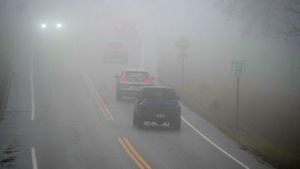Residents of Hong Kong and nearby coastal regions are waking up to alarming news as recent geological assessments indicate the Nankai Trough, located off Japan's southern coast, has seen its earthquake risk rise. According to experts, the probability of experiencing significant seismic activity along this fault line has surged, with estimates placing the likelihood of major earthquakes at levels as high as 82% over the next 30 years.
The Hong Kong Observatory has taken heed of these findings and released information concerning the potential consequences for the city should such earthquakes occur. The major concern stems from the fact seismic waves from the Nankai Trough could generate tsunamis capable of impacting coastal areas, with Hong Kong being within reach of these waves.
What exactly is the Nankai Trough? This geological feature stretches approximately 700 kilometers along the seabed, extending from Suruga Bay to Hyuganada, and marks the converging boundary between the Philippine Sea Plate and the Eurasian Plate. This region is known for its tectonic activity, with studies showing significant earthquakes have occurred roughly every 88.2 years. The last large seismic event recorded was the Showa Nankai Earthquake, which struck with a magnitude of 8.0 back in 1946, meaning it has now been 79 years since such intensity has been experienced.
Latest reports from the Japan Earthquake Research Committee indicate the Nankai Trough could see earthquakes of magnitude 8 to 9, with historical records outlining occurrences every 100 to 200 years. Such earthquakes could trigger tsunamis, with estimations showing waves could exceed 10 meters on Japan's Pacific coastline. Given the proximity, Hong Kong could potentially feel the effects within six hours following such quakes.
Four main factors have been outlined by the Observatory as key determinants affecting tsunami wave amplitude, including the earthquake's epicenter location and magnitude, the rupturing process causing the earthquake, nearby geological structures, and coastal and seabed topography. This complexity emphasizes the need for preparedness as the potential for measurable tsunami waves reaching Hong Kong remains present, particularly if large-scale seismic activities occur.
The Observatory's models indicate if, for example, there were a shallow earthquake reaching magnitude 9.1 sourced from the Nankai Trough, significant impacts could be felt along parts of Hong Kong's coastline. Conversely, smaller-scale events registering below magnitude 8.0 might only induce minor water level anomalies, potentially unnoticed by residents.
Some locals are familiar with this threat: during the 2011 Tōhoku earthquake, which measured 9.0 and produced substantial tsunami wave impacts across the Pacific, Hong Kong recorded water-level anomalies reaching 0.2 meters. This history creates trepidation as the potential for future events remains on the scientific horizon.
The Observatory is committed to monitoring seismic activities on this scale, ready to deploy tsunami warnings swiftly should waves be expected to reach the city within three hours. The latest findings underline how interconnected geological events can have far-reaching impacts.
Addressing these concerns, emergency preparedness measures are being reinforced, urging residents to stay informed and aware of tsunami warnings, as these could be life-saving during seismic events originating from distant locations.
The message is clear: the geological dynamics at play mean it is imperative for Hong Kong’s Government and its citizens to remain vigilant. The old adage holds true—the ocean, beautiful and vast, can also carry dangers miles beyond its shores. Staying informed and prepared could be the difference when the next wave of seismic activity hits.



